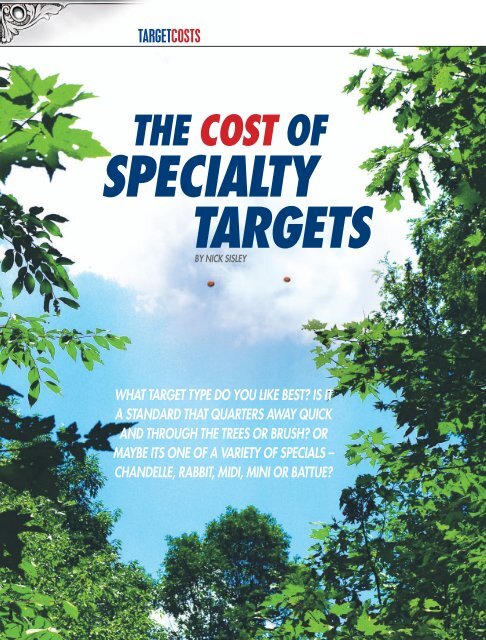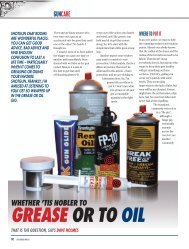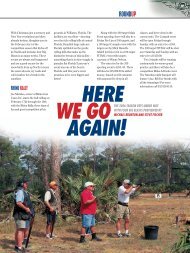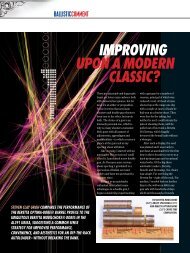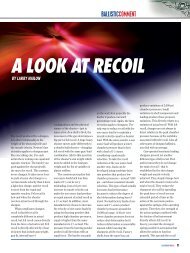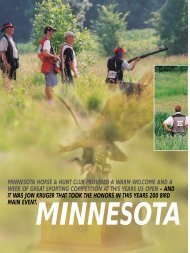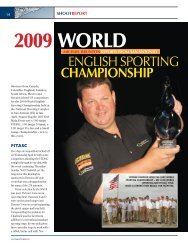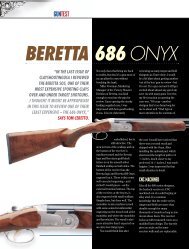the cost of specialty targets - Clay Shooting USA
the cost of specialty targets - Clay Shooting USA
the cost of specialty targets - Clay Shooting USA
You also want an ePaper? Increase the reach of your titles
YUMPU automatically turns print PDFs into web optimized ePapers that Google loves.
TARGETCOSTSstations so <strong>the</strong>y need more traps,and/or are shooters <strong>the</strong>mselvesbuying traps at a respectable clipfor <strong>the</strong>ir own practice? The answermay be all <strong>of</strong> <strong>the</strong> above and more.At Promatic I first talked withAndy Perkins. He confirms thatsome <strong>of</strong> <strong>the</strong>ir traps are up in price,some as much as $150 comparedto two years ago. Their leastexpensive trap is <strong>the</strong> Elite at $800,while <strong>the</strong>ir Super Sporter 8 is seenmost <strong>of</strong>ten at clay courses. This isa tilt and turn model with highcapacity at $3095.I had a particularly interestingreport from Promatic’s headhoncho, Julian Coy. He told methat over <strong>the</strong> last couple <strong>of</strong> years<strong>the</strong>re has been a significantincrease in <strong>cost</strong> <strong>of</strong> <strong>the</strong> rawmaterials used in <strong>the</strong>ir traps(probably o<strong>the</strong>r trapmanufacturers are experiencing<strong>the</strong> same problem). Such rising<strong>cost</strong>s are mainly associated withmetals used in trap manufacture –like steel, alloy, copper andNEW FROM PROMATIC, THEIRDOWNHILL THROWER. THISCOMPLIMENTS THEIR CURRENTRANGE OF SPECIALTY TRAPS.stainless steel. World metal priceshave gone up – and seem to beconsistently rising. Coy went on,“We’ve done our best to shelter ourcustomers from <strong>the</strong>se increases,but to give one example, we fithigh grade stainless steel throwingplates to all our commercial trapsto avoid rust and pitting. The <strong>cost</strong><strong>of</strong> that stainless has more thandoubled in <strong>the</strong> last 12 months.“Some <strong>of</strong> our trap prices haveremained static, while o<strong>the</strong>rs haverisen. However, remember that <strong>the</strong>average commercial customer willmake our traps last 10 years, andsome stretch this to 20 years. If atrap can throw 35,000 <strong>targets</strong> ayear, <strong>the</strong> added <strong>cost</strong> is one 400th <strong>of</strong>a cent, hardly significant or evenmeasurable“The increased <strong>cost</strong>s <strong>of</strong> <strong>targets</strong>like rabbits, battues and o<strong>the</strong>rs are<strong>of</strong> more concern than trap priceincreases. We don’t want to see<strong>specialty</strong> <strong>targets</strong> disappearing from<strong>the</strong> competition scene – or even<strong>the</strong> league or practice sector.”Here’s what Promatic hasdone to help range owners<strong>of</strong>fset rising target <strong>cost</strong>s.● The company has anew counting systemthat <strong>of</strong>fers so muchmore control overtarget <strong>cost</strong>s. Cluboperators can charge adifferent rate for rabbits or minis,for example. Clubs can charge, asan example, 30 cents for a standardand 35 cents for a battue or rabbit.Fur<strong>the</strong>r, different rates can becharged to members, guests andnon-members – and not only forsporting but <strong>the</strong> o<strong>the</strong>r claytarget games as well. Coy saysthat customers who haveimplemented <strong>the</strong>ir Promatic<strong>Clay</strong>mate system report reducedwaste and revenue increases <strong>of</strong> 30– 40 percent. He thinks this systemis <strong>the</strong> best way for any shootingground to fundamentally changeits financial position for <strong>the</strong> better.It is for <strong>the</strong> good <strong>of</strong> everyone in <strong>the</strong>sport to have pr<strong>of</strong>itable clubs.● Ra<strong>the</strong>r than pay for moreexpensive <strong>specialty</strong> <strong>targets</strong>,Promatic is trying to get more out<strong>of</strong> standard clays with <strong>the</strong>innovative technology <strong>the</strong>y buildinto <strong>the</strong>ir machines. Recently thiscompany introduced a SportingDoubles Thrower, a DownhillThrower and a Ranger ChandelleRabbit – which can flip a standardclay mid-air to present a totallydifferent bird. These traps allowtarget setters to produce a muchwider range <strong>of</strong> presentations whilestill using cheaper standard<strong>targets</strong>.● Much <strong>of</strong> Promatic’s research anddevelopment goes into what Coycalls “Zero no birds.” It has simplybecome too expensive for cluboperators to have target breakage.This is particularly true <strong>of</strong> rabbits,minis and battues.● When it comes to <strong>the</strong> mini target,<strong>the</strong> company has traps with <strong>the</strong>irown specific mini carousels, knifeedges and let-down ramps todramatically reduce breakage.How about sales? Coy says,“Large projects have slowed, butthat sales slack has been picked upby smaller clubs increasing<strong>the</strong>ir spending. Several <strong>of</strong> ourtraps have seen dramatic growthwhile demand for o<strong>the</strong>rs hasdeclined. Customers want value,and in <strong>the</strong> current marketwants financial help. That’swhy we have launchedPromatic Commercial Lending toprovide flexible financing for clubsthat are finding traditional banksunresponsive. The market isdifficult to read, but I think we willend <strong>the</strong> year with around 10percent growth, which is lowerthan <strong>the</strong> 15 percent growth we sawin 2007 – but still points to ahealthy industry.”DIFFERENT PRESENTATIONSAn important factor with trapselection, as far as <strong>specialty</strong> <strong>targets</strong>go, is to choose traps that arecapable <strong>of</strong> throwing multiple targettypes. Purchasing a trap that canonly throw so-called standard<strong>targets</strong> severely limits <strong>the</strong> interestthat a club can create for itscustomers.At Atlas Traps I talked withJohn Cere and Scott Manspeaker.This company markets four trapmodels. They have not increasedprices since January 1, 2007. Allfour <strong>of</strong> <strong>the</strong>ir target throwers, <strong>the</strong>AT400, AT250, AT50 and <strong>the</strong>Patriot will throw standard, midiTHE ATLAS AT250 HOLDS 250 BIRDS,HAS A COMMERCIAL GEAR MOTOR, A75-FOOT RELEASE CORD AND COMESWITH A FIVE-YEAR WARRANTY.48 C L AYS H O O T I N G U S A
and battue <strong>targets</strong>. By <strong>the</strong> end <strong>of</strong>this year <strong>the</strong>y hope to able to throwmini 60s from <strong>the</strong> same models.Also later this year, Atlas will havea rabbit/teal/chandelle model toadd to <strong>the</strong>ir <strong>of</strong>ferings.CLUB COMMENTSam and Frieda Lancaster were<strong>the</strong> first club owners I talked toabout rising shooting <strong>cost</strong>s. Theyrun <strong>Clay</strong>thorne Lodge inColumbus, Kansas, home <strong>of</strong> manyBig Blasts over <strong>the</strong> years. Samsays shooting is always <strong>of</strong>f at<strong>Clay</strong>thorne in July and August, but<strong>the</strong> summer <strong>of</strong> 2008 saw fewershooters than ever. Practiceshooting up until July and August<strong>of</strong> this year has remained fairlyconstant, but I was told that thisparticipation needs to increase.The target thrown most <strong>of</strong>ten at<strong>Clay</strong>thorne is <strong>the</strong> White FlyerPheasant (standard). Not only is aharder standard target better forthrowing faster and longer birdswithout breakage (more springpressure), <strong>the</strong>y also hold up betterin outside storage or when beingtrucked to individual sportingstations. The Lancasters arehoping <strong>the</strong>y will not have to cutback on <strong>the</strong> throwing <strong>of</strong> <strong>specialty</strong><strong>targets</strong>, but it is more expensive tothrow most <strong>of</strong> <strong>the</strong>m, so it might beconsidered in time.Chuck Frazier is at Hunter’sPointe Sporting <strong>Clay</strong>s nearWashington, North Carolina. He’sboth a range owner and a <strong>targets</strong>etter. Frazier says <strong>the</strong>re has beenno increase passed along toshooters so far at Hunter’s Pointe.“One reason for that is because<strong>specialty</strong> <strong>targets</strong> comprise onlyabout 10 percent <strong>of</strong> <strong>the</strong> <strong>targets</strong> wethrow – and I think this is true atmany ranges.”He has a truck that he takes toshoots where he is going to set <strong>the</strong><strong>targets</strong> – in which he can carry asmany as 50 traps. For <strong>specialty</strong><strong>targets</strong> he carries more traps thatthrow midi 90mm <strong>targets</strong> than anyo<strong>the</strong>r. His target <strong>cost</strong>s are about 50cents more per box <strong>of</strong> midis –compared to standard <strong>targets</strong> – but144 midis are in <strong>the</strong> box(compared with 135 standard<strong>targets</strong> per box). Consequently,midis can be thrown for about <strong>the</strong>same price as standards.However, at his Hunter’s Pointehe says maintenance <strong>cost</strong>s arereally skyrocketing. He uses dieselin his grass mowing machines, has alot <strong>of</strong> grass to cut, and during someperiods <strong>of</strong> <strong>the</strong> year has to cut twice aWHILE SHOOTERS BEMOAN THE RISING COSTOF TRAVEL, HOTELS, ENTRY FEES ANDAMMUNITION, GROUNDS AND CLUBS AREALSO FACING INFLATORY COST PRESSURESTHAT INCLUDE FUEL COSTS, MAINTENANCE,TARGETS AND TRAP INVESTMENT.50 C L AYS H O O T I N G U S A
week. He thinks <strong>the</strong> <strong>cost</strong> <strong>of</strong> shootingwill go up a dollar or two per round<strong>of</strong> 50 – but this will be more to<strong>of</strong>fset increasing maintenance<strong>cost</strong>s than <strong>specialty</strong> target <strong>cost</strong>s.Mike McAlpine, formerly <strong>the</strong>NSCA Chief <strong>Shooting</strong> Instructor, isin constant demand as a <strong>targets</strong>etter. He reckons that throwing<strong>specialty</strong> midi 90mm <strong>targets</strong> is nodifferent from a <strong>cost</strong> standpointthan throwing standard birds since<strong>the</strong> <strong>cost</strong>s are so similar – just asChuck Frazier advised. Mikedoesn’t like throwing mini 60mm<strong>targets</strong>, he says most folks cannotsee <strong>the</strong>m, plus <strong>the</strong>se little <strong>targets</strong>are very influenced by wind –which can vary during a multipleday championship. “Bob Bristerwas one <strong>of</strong> my best friends – andhe had his share <strong>of</strong> eye problemslater in life. When I set <strong>targets</strong> I’dask for Bob’s input. If he could see<strong>the</strong>m – most any shooter could! Ienjoy throwing battues far more.They’re easy to see and can bethrown in so many different ways,”Mike explained.McAlpine was setting <strong>targets</strong> at<strong>the</strong> recent Boomer Esiason AllAmerican Sporting <strong>Clay</strong>sChampionship & World FITASCChallenge at Elk Creek HuntClub when we talked. In 2007<strong>the</strong>y threw numerous battues atthat tournament – but far fewerbattues were thrown this year.Because <strong>of</strong> <strong>cost</strong>? Probably.So – <strong>the</strong> picture is not all bleakfor <strong>the</strong> future <strong>of</strong> our sport. <strong>Clay</strong>TOUGH TIMEStarget shooting will survive. Wemay see some participants dropout. We may see o<strong>the</strong>rs shoot less.We may see some travel less. Butclubs all over America are going tocontinue to throw fun andchallenging <strong>targets</strong>.WHAT COST?So <strong>the</strong>re you have it. While shootersbemoan <strong>the</strong> rising <strong>cost</strong> <strong>of</strong> travel,hotels, entry fees and ammunition,grounds and clubs are also facinginflatory <strong>cost</strong> pressures thatinclude fuel <strong>cost</strong>s, maintenance,<strong>targets</strong> and trap investment. Just aswe shooters look to ‘reduce’ our<strong>cost</strong>s <strong>of</strong> shooting in this difficulteconomic period, club owners,target setters and Big Blastorganizers are sure to want toreduce <strong>the</strong>ir <strong>cost</strong>s (if only to holdcurrent prices). Lets hope its not at<strong>the</strong> expense <strong>of</strong> <strong>specialty</strong> <strong>targets</strong>.Nick Sisley can be contacted atnicksisley@hotmail.comI wanted to get a selection <strong>of</strong> all <strong>the</strong> target types to photograph to accompany this article. I contacted <strong>the</strong> sportingcourse that was closest to where I live – McCrae’s Sporting <strong>Clay</strong>s near Worthington, (PA). Not only did I find <strong>the</strong>y had no<strong>targets</strong>, <strong>the</strong>y had just shut down <strong>the</strong>ir sporting course – so ano<strong>the</strong>r course has fallen to <strong>the</strong>se hard economic times.Then I contacted Chestnut Ridge Sporting <strong>Clay</strong>s and Dave Yurko (724-694-9831). Dave says shooting hasconsiderable fallen <strong>of</strong>f. He and his bro<strong>the</strong>r acquired <strong>the</strong> club in 1999, when clay target prices were close to half what<strong>the</strong>y are now. <strong>Shooting</strong> is down at Chestnut Ridge, but <strong>the</strong> club continues to hang on. (Dave did have all <strong>the</strong> differentsporting target types needed – so thanks to him).C L AYS H O O T I N G U S A 51


